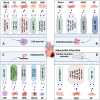Emerging roles of extracellular vesicle-associated non-coding RNAs in hypoxia: Insights from cancer, myocardial infarction and ischemic stroke
- PMID: 35966580
- PMCID: PMC9373807
- DOI: 10.7150/thno.73931
Emerging roles of extracellular vesicle-associated non-coding RNAs in hypoxia: Insights from cancer, myocardial infarction and ischemic stroke
Abstract
Hypoxia is a central pathophysiological component in cancer, myocardial infarction and ischemic stroke, which represent the most common medical conditions resulting in long-term disability and death. Recent evidence suggests common signaling pathways in these diverse settings mediated by non-coding RNAs (ncRNAs), which are packaged in extracellular vesicles (EVs) protecting ncRNAs from degradation. EVs are a heterogeneous group of lipid bilayer-covered vesicles released from virtually all cells, which have important roles in intercellular communication. Recent studies pointed out that ncRNAs including long non-coding RNAs (lncRNAs) and microRNAs (miRNAs) are selectively sorted into EVs, modulating specific aspects of cancer development, namely cell proliferation, migration, invasion, angiogenesis, immune tolerance or drug resistance, under conditions of hypoxia in recipient cells. In myocardial infarction and stroke, ncRNAs shuttled via EVs have been shown to control tissue survival and remodeling post-hypoxia by regulating cell injury, inflammatory responses, angiogenesis, neurogenesis or neuronal plasticity. This review discusses recent evidence on EV-associated ncRNAs in hypoxic cancer, myocardial infarction and stroke, discussing their cellular origin, biological function and disease significance. The emerging concept of lncRNA-circular RNA/ miRNA/ mRNA networks is outlined, upon which ncRNAs synergistically respond to hypoxia in order to modify disease responses. Particular notion is given to ncRNAs participating in at least two of the three conditions, which revealed a large degree of overlaps across pathophysiological conditions. Possible roles of EV-ncRNAs as therapeutic products or theranostic markers are defined.
© The author(s).
Conflict of interest statement
Competing Interests: D.M.H., B.G. and T.R.D. hold a patent on extracellular vesicles for the treatment of inflammatory conditions (US9877989B2).
Figures




Similar articles
-
Extracellular Vesicles as Delivery Shippers for Noncoding RNA-Based Modulation of Angiogenesis: Insights from Ischemic Stroke and Cancer.Small. 2023 Apr;19(17):e2205739. doi: 10.1002/smll.202205739. Epub 2023 Jan 2. Small. 2023. PMID: 36592424 Review.
-
Extracellular Vesicles as Delivery Vehicles for Non-Coding RNAs: Potential Biomarkers for Chronic Liver Diseases.Biomolecules. 2024 Feb 26;14(3):277. doi: 10.3390/biom14030277. Biomolecules. 2024. PMID: 38540698 Free PMC article. Review.
-
Extracellular vesicles-mediated noncoding RNAs transfer in cancer.J Hematol Oncol. 2017 Feb 23;10(1):57. doi: 10.1186/s13045-017-0426-y. J Hematol Oncol. 2017. PMID: 28231804 Free PMC article. Review.
-
Extracellular vesicle long non-coding RNAs and circular RNAs: Biology, functions and applications in cancer.Cancer Lett. 2020 Oct 1;489:111-120. doi: 10.1016/j.canlet.2020.06.006. Epub 2020 Jun 16. Cancer Lett. 2020. PMID: 32561417 Review.
-
Neuronal and Glial Communication via Non-Coding RNAs: Messages in Extracellular Vesicles.Int J Mol Sci. 2022 Dec 28;24(1):470. doi: 10.3390/ijms24010470. Int J Mol Sci. 2022. PMID: 36613914 Free PMC article. Review.
Cited by
-
Extracellular vesicles set the stage for brain plasticity and recovery by multimodal signalling.Brain. 2024 Feb 1;147(2):372-389. doi: 10.1093/brain/awad332. Brain. 2024. PMID: 37768167 Free PMC article. Review.
-
Molecular and metabolic regulation of immunosuppression in metastatic pancreatic ductal adenocarcinoma.Mol Cancer. 2023 Jul 24;22(1):118. doi: 10.1186/s12943-023-01813-y. Mol Cancer. 2023. PMID: 37488598 Free PMC article. Review.
-
MicroRNAs in diabetic macroangiopathy.Cardiovasc Diabetol. 2024 Sep 16;23(1):344. doi: 10.1186/s12933-024-02405-w. Cardiovasc Diabetol. 2024. PMID: 39285459 Free PMC article. Review.
-
The Role of Extracellular Vesicles in Efferocytosis.Mini Rev Med Chem. 2024;24(6):634-641. doi: 10.2174/0113895575247690230926113455. Mini Rev Med Chem. 2024. PMID: 37859308 Review.
-
Tumor-derived systems as novel biomedical tools-turning the enemy into an ally.Biomater Res. 2023 Nov 9;27(1):113. doi: 10.1186/s40824-023-00445-z. Biomater Res. 2023. PMID: 37946275 Free PMC article. Review.
References
-
- Benjamin EJ, Muntner P, Alonso A, Bittencourt MS, Callaway CW, Carson AP. et al. Heart Disease and Stroke Statistics-2019 Update: A Report From the American Heart Association. Circulation. 2019;139:e56–e528. - PubMed
-
- Wenger RH. Mammalian oxygen sensing, signalling and gene regulation. J Exp Biol. 2000;203:1253–63. - PubMed
-
- Fandrey J, Gassmann M. Oxygen sensing and the activation of the hypoxia inducible factor 1 (HIF-1)-invited article. Adv Exp Med Biol. 2009;648:197–206. - PubMed
Publication types
MeSH terms
Substances
LinkOut - more resources
Full Text Sources
Medical

